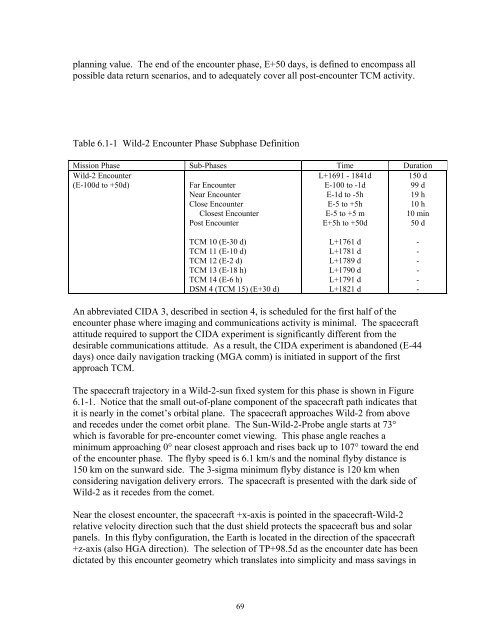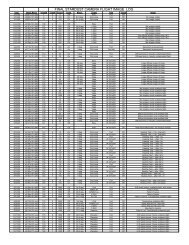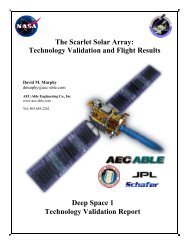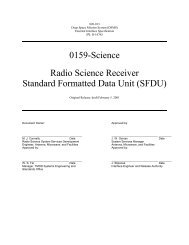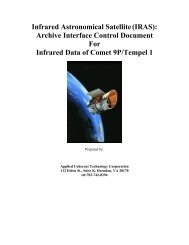MISSION PLAN - PDS Small Bodies Node
MISSION PLAN - PDS Small Bodies Node
MISSION PLAN - PDS Small Bodies Node
Create successful ePaper yourself
Turn your PDF publications into a flip-book with our unique Google optimized e-Paper software.
planning value. The end of the encounter phase, E+50 days, is defined to encompass all<br />
possible data return scenarios, and to adequately cover all post-encounter TCM activity.<br />
Table 6.1-1 Wild-2 Encounter Phase Subphase Definition<br />
Mission Phase Sub-Phases Time Duration<br />
Wild-2 Encounter<br />
(E-100d to +50d)<br />
Far Encounter<br />
Near Encounter<br />
Close Encounter<br />
Closest Encounter<br />
Post Encounter<br />
L+1691 - 1841d<br />
E-100 to -1d<br />
E-1d to -5h<br />
E-5 to +5h<br />
E-5 to +5 m<br />
E+5h to +50d<br />
150 d<br />
99 d<br />
19 h<br />
10 h<br />
10 min<br />
50 d<br />
TCM 10 (E-30 d)<br />
TCM 11 (E-10 d)<br />
TCM 12 (E-2 d)<br />
TCM 13 (E-18 h)<br />
TCM 14 (E-6 h)<br />
DSM 4 (TCM 15) (E+30 d)<br />
L+1761 d<br />
L+1781 d<br />
L+1789 d<br />
L+1790 d<br />
L+1791 d<br />
L+1821 d<br />
-<br />
-<br />
-<br />
-<br />
-<br />
-<br />
An abbreviated CIDA 3, described in section 4, is scheduled for the first half of the<br />
encounter phase where imaging and communications activity is minimal. The spacecraft<br />
attitude required to support the CIDA experiment is significantly different from the<br />
desirable communications attitude. As a result, the CIDA experiment is abandoned (E-44<br />
days) once daily navigation tracking (MGA comm) is initiated in support of the first<br />
approach TCM.<br />
The spacecraft trajectory in a Wild-2-sun fixed system for this phase is shown in Figure<br />
6.1-1. Notice that the small out-of-plane component of the spacecraft path indicates that<br />
it is nearly in the comet’s orbital plane. The spacecraft approaches Wild-2 from above<br />
and recedes under the comet orbit plane. The Sun-Wild-2-Probe angle starts at 73°<br />
which is favorable for pre-encounter comet viewing. This phase angle reaches a<br />
minimum approaching 0° near closest approach and rises back up to 107° toward the end<br />
of the encounter phase. The flyby speed is 6.1 km/s and the nominal flyby distance is<br />
150 km on the sunward side. The 3-sigma minimum flyby distance is 120 km when<br />
considering navigation delivery errors. The spacecraft is presented with the dark side of<br />
Wild-2 as it recedes from the comet.<br />
Near the closest encounter, the spacecraft +x-axis is pointed in the spacecraft-Wild-2<br />
relative velocity direction such that the dust shield protects the spacecraft bus and solar<br />
panels. In this flyby configuration, the Earth is located in the direction of the spacecraft<br />
+z-axis (also HGA direction). The selection of TP+98.5d as the encounter date has been<br />
dictated by this encounter geometry which translates into simplicity and mass savings in<br />
69


